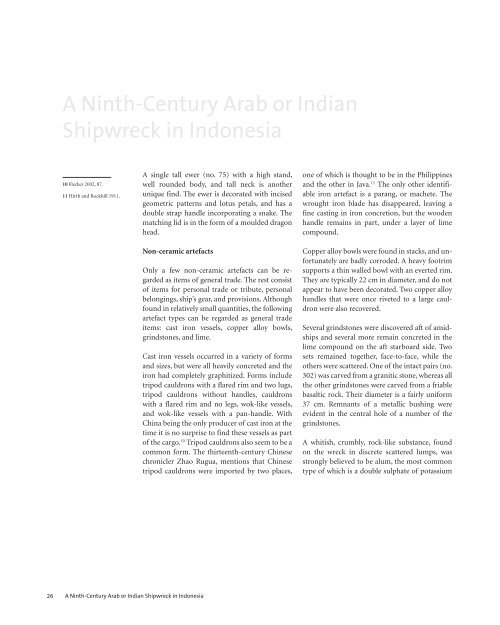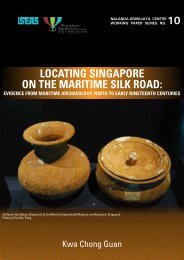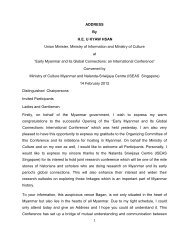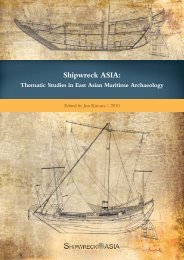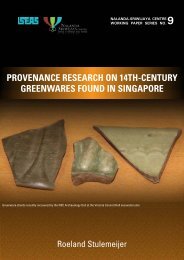You also want an ePaper? Increase the reach of your titles
YUMPU automatically turns print PDFs into web optimized ePapers that Google loves.
A Ninth-Century Arab or Indian<br />
Shipwreck in Indonesia<br />
10 <strong>Flecker</strong> 2002, 87.<br />
11 Hirth and Rockhill 1911.<br />
A single tall ewer (no. 75) with a high stand,<br />
well rounded body, and tall neck is another<br />
unique find. The ewer is decorated with incised<br />
geometric patterns and lotus petals, and has a<br />
double strap handle incorporating a snake. The<br />
matching lid is in the form of a moulded dragon<br />
head.<br />
Non-ceramic artefacts<br />
Only a few non-ceramic artefacts can be regarded<br />
as items of general trade. The rest consist<br />
of items for personal trade or tribute, personal<br />
be longings, ship’s gear, and provisions. Although<br />
found in relatively small quantities, the fol lowing<br />
artefact types can be regarded as general trade<br />
items: cast iron vessels, copper alloy bowls,<br />
grindstones, and lime.<br />
Cast iron vessels occurred in a variety of forms<br />
and sizes, but were all heavily concreted and the<br />
iron had completely graphitized. Forms include<br />
tripod cauldrons with a flared rim and two lugs,<br />
tripod cauldrons without handles, cauldrons<br />
with a flared rim and no legs, wok-like vessels,<br />
and wok-like vessels with a pan-handle. With<br />
China being the only producer of cast iron at the<br />
time it is no surprise to find these vessels as part<br />
of the cargo. 10 Tripod cauldrons also seem to be a<br />
common form. The thirteenth-century Chinese<br />
chronicler Zhao Rugua, mentions that Chinese<br />
tripod cauldrons were imported by two places,<br />
one of which is thought to be in the Philippines<br />
and the other in Java. 11 The only other identifiable<br />
iron artefact is a parang, or machete. The<br />
wrought iron blade has disappeared, leaving a<br />
fine casting in iron concretion, but the wooden<br />
handle remains in part, under a layer of lime<br />
compound.<br />
Copper alloy bowls were found in stacks, and unfortunately<br />
are badly corroded. A heavy footrim<br />
supports a thin walled bowl with an everted rim.<br />
They are typically 22 cm in diameter, and do not<br />
appear to have been decorated. Two copper alloy<br />
handles that were once riveted to a large cauldron<br />
were also recovered.<br />
Several grindstones were discovered aft of amidships<br />
and several more remain concreted in the<br />
lime compound on the aft starboard side. Two<br />
sets remained together, face-to-face, while the<br />
others were scattered. One of the intact pairs (no.<br />
302) was carved from a granitic stone, whereas all<br />
the other grindstones were carved from a friable<br />
basaltic rock. Their diameter is a fairly uniform<br />
37 cm. Remnants of a metallic bushing were<br />
evident in the central hole of a number of the<br />
grindstones.<br />
A whitish, crumbly, rock-like substance, found<br />
on the wreck in discrete scattered lumps, was<br />
strongly believed to be alum, the most common<br />
type of which is a double sulphate of potassium<br />
26 A Ninth-Century Arab or Indian Shipwreck in Indonesia


